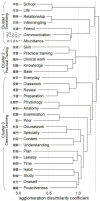An evaluation of rehabilitation students' learning goals in their first year: a text mining approach
- PMID: 38545511
- PMCID: PMC10965620
- DOI: 10.3389/fmed.2024.1239916
An evaluation of rehabilitation students' learning goals in their first year: a text mining approach
Abstract
Introduction: Qualitative information in the form of written reflection reports is vital for evaluating students' progress in education. As a pilot study, we used text mining, which analyzes qualitative information with quantitative features, to investigate how rehabilitation students' goals change during their first year at university.
Methods: We recruited 109 first-year students (66 physical therapy and 43 occupational therapy students) enrolled in a university rehabilitation course. These students completed an open-ended questionnaire about their learning goals at the time of admission and at 6 and 12 months after admission to the university. Text mining was used to objectively interpret the descriptive text data from all three-time points to extract frequently occurring nouns at once. Then, hierarchical cluster analysis was performed to generate clusters. The number of students who mentioned at least one noun in each cluster was counted and the percentages of students in each cluster were compared for the three periods using Cochran's Q test.
Results: The 31 nouns that appeared 10 or more times in the 427 sentences were classified into three clusters: "Socializing," "Practical Training," and "Classroom Learning." The percentage of students in all three clusters showed significant differences across the time periods (p < 0.001 for "Socializing"; p < 0.01 for "Practical Training" and "Classroom Learning").
Conclusion: These findings suggest that the students' learning goals changed during their first year of education. This objective analytical method will enable researchers to examine transitional trends in students' reflections and capture their psychological changes, making it a useful tool in educational research.
Keywords: cluster analysis; professional education; rehabilitation; students; text mining.
Copyright © 2024 Kitamura, Takeda, Uehara, Yoshida, Ota, Tanabe, Takeda, Koyama, Sakurai and Kanada.
Conflict of interest statement
The authors declare that the research was conducted in the absence of any commercial or financial relationships that could be construed as a potential conflict of interest.
Figures


Similar articles
-
Growth of rehabilitation students in first and second years: A text mining approach.Fujita Med J. 2025 May;11(2):98-104. doi: 10.20407/fmj.2024-024. Epub 2024 Dec 27. Fujita Med J. 2025. PMID: 40309005 Free PMC article.
-
Towards teaching analytics: a contextual model for analysis of students' evaluation of teaching through text mining and machine learning classification.Educ Inf Technol (Dordr). 2022;27(3):3891-3933. doi: 10.1007/s10639-021-10751-5. Epub 2021 Oct 11. Educ Inf Technol (Dordr). 2022. PMID: 34658654 Free PMC article.
-
Utilising virtual environments for radiation therapy teaching and learning.J Med Imaging Radiat Sci. 2021 Dec;52(4S):S83-S95. doi: 10.1016/j.jmir.2021.07.001. Epub 2021 Jul 31. J Med Imaging Radiat Sci. 2021. PMID: 34344633 Clinical Trial.
-
The effects of flipped classrooms to improve learning outcomes in undergraduate health professional education: A systematic review.Campbell Syst Rev. 2023 Jul 7;19(3):e1339. doi: 10.1002/cl2.1339. eCollection 2023 Sep. Campbell Syst Rev. 2023. PMID: 37425620 Free PMC article. Review.
-
Nursing students learning transfer from classroom to clinical practice: An integrative review.Nurse Educ Pract. 2023 Aug;71:103731. doi: 10.1016/j.nepr.2023.103731. Epub 2023 Jul 24. Nurse Educ Pract. 2023. PMID: 37517230 Review.
Cited by
-
Growth of rehabilitation students in first and second years: A text mining approach.Fujita Med J. 2025 May;11(2):98-104. doi: 10.20407/fmj.2024-024. Epub 2024 Dec 27. Fujita Med J. 2025. PMID: 40309005 Free PMC article.
References
-
- Romero C, Ventura S. Educational data mining: a review of the state of the art. IEEE Trans Syst Man Cybern C. (2010) 40:601–18. doi: 10.1109/tsmcc.2010.2053532 - DOI
-
- Romero C, Ventura S. Educational data mining: a survey from 1995 to 2005. Expert Syst Appl. (2007) 33:135–46. doi: 10.1016/j.eswa.2006.04.005 - DOI
LinkOut - more resources
Full Text Sources
Research Materials

